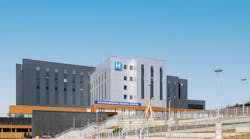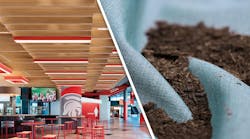Going Green From The Ground Up
The green build wave is rising, and right now general contractors have the opportunity to ride its crest. It is fast becoming expected that professionals in the building trades are ready, willing and able to work green — and that means understanding the U.S. Green Building Council's LEED standards (Leadership in Energy and Environmental Design).
Contractor's LEEDing Role
In the chain of events that leads up to LEED certification, general contractors have a special "watchdog" role. It is the general contractor's responsibility to keep accurate records on all materials used that are required to meet LEED standards. Consequently, it is imperative that not only the general contractor but also sub-contractors understand LEED certification, its requirements and its growing importance in winning bids.
One area in which general and sub-contractors can get the jump on understanding LEED is landscape architecture. In fact, eight to 10 current LEED credits are available to projects that incorporate such sustainable practices. But the real news is that the number of available green site credits is about to take off.
New Guidelines Coming
Current LEED standards certify green buildings and sustainable structures. However, no official guidelines from the U.S. Green Building Council focus exclusively on site exteriors. The American Society of Landscape Architects (ASLA) is spearheading an effort to set this oversight straight. Called the "Sustainable Sites Initiative" (SSI), this new rating system will recognize performance in achieving sustainable sites much as LEED recognizes sustainable buildings. And the U.S. Green Building Council is on board: SSI guidelines will be incorporated into the next iteration of LEED standards.
Once the SSI guidelines are published in spring 2009, general contractors, landscape architects, developers, builders, and maintenance crews who are prepared to take advantage of them stand to see interest in obtaining their services rising.
Key Elements
What are the key elements to include in future bids, to ensure your proposal will be at the forefront of the growing green trend? Several components of your landscape plan, such as water use, habitat protection and reduced light pollution, can demonstrate to clients and other contractors an understanding of sustainable building practices. And (we should be quick to point out) these practices can earn a project LEED credits today — and often with less investment per credit than other qualifying activities.
Look at water use. The demand for high-quality municipal drinking water has risen greatly — up 209 percent since 1950, according to the Environmental Protection Agency. Most sites are designed to use this "potable" water only once, and rainwater is allowed to just flow off site. Sustainable sites treat water runoff as a resource, building in grass swells or rain barrels to harvest water and recycle it for use in irrigation, water features and custodial applications.
Green roofs are another way to reduce a site's dependence on the municipal grid. A green roof is insulating, bringing down heating and cooling costs. And the plants on a green roof protect it from harmful UV rays, prolonging the life of the roof and decreasing future maintenance costs.
Information about other steps you can take today to "green" your sites and plans is available from the Sustainable Sites Initiative and the U.S. Green Building Council. A LEED accredited landscape architect can provide you with expert advice and perform a design payback analysis to spotlight future savings for your clients for going green right now.
In the past, natural elements in design were viewed purely aesthetically. Selecting native plants and placing them to properly reduce heat islands and wind effects does not take away from the appearance of a site at all. Providing outdoor space for physical activity contributes to healthier residents and opportunities for social interaction, leading to lower absenteeism and higher productivity. A comfortable outdoor walking space with simple tree and grass cover was even correlated with lower crime rates in a 2003 study of urban Chicago from the Journal of Arboriculture. Great job, grass and trees!
Adopting green practices does require commitment, a pledge to look critically at the way a facility is built and run, and a willingness to change plans if needed. That may not be easy, but it is an effort that will pay for itself in improved health, greater productivity, less maintenance, reduced energy costs, and increased asset value.
| Author Information |
| Jo Ann Jarreau is a U.S. Green Building Council LEED Accredited Professional and a member of the American Society of Landscape Architects. For more information on Jarreau Inc., call (713) 682-5299 or go to www.jaj-las.com. |

